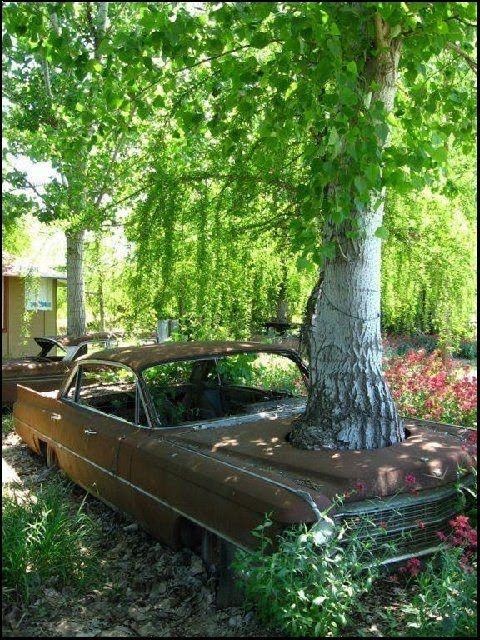
If you know the location of any of these trees please let us know!
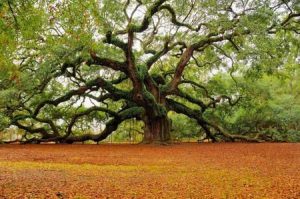
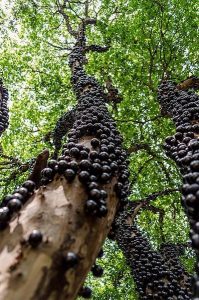
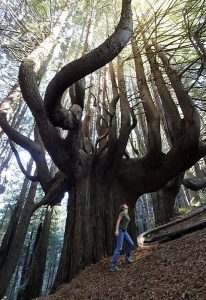



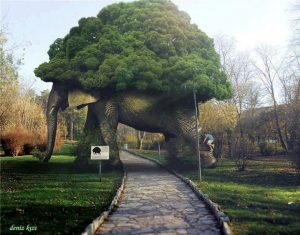

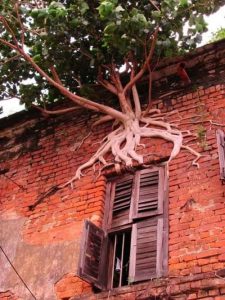
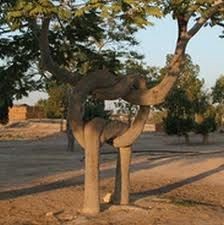


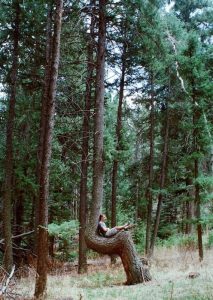
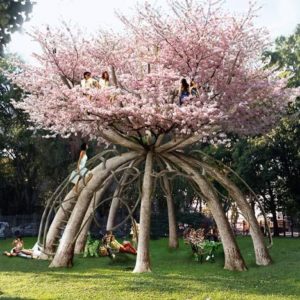
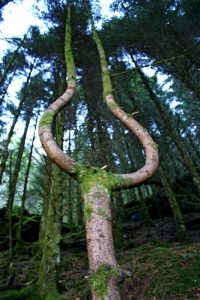
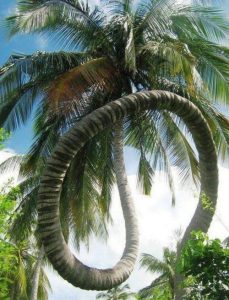



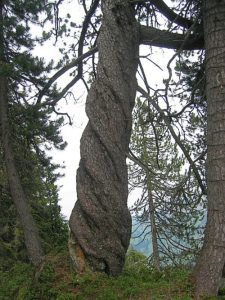
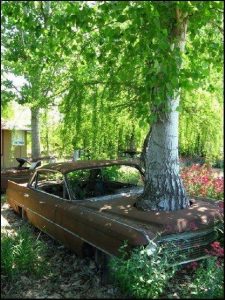


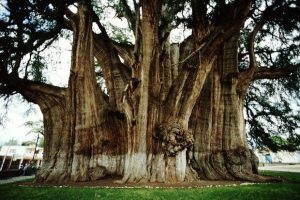


If you know the location of any of these trees please let us know!

























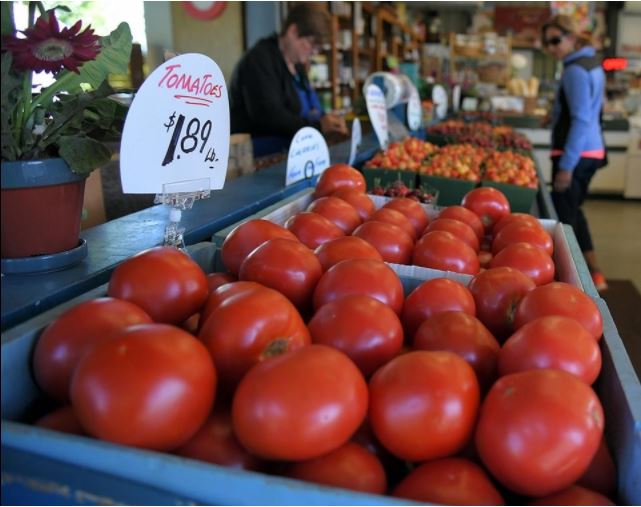
http://www.recordnet.com/news/20170528/fruit-bowl-still-fresh-as-ever-at-70
STOCKTON — A lone eucalyptus tree, more than 100 years old, still stands on the edge of Waterloo Road where Frank and Ina Lucchetti sowed the seeds of their family business.
It remains large and firm, the only survivor of the 1946 chimney fire that burned down the family’s home and adjacent trees and of the 1991 frost that claimed its two remaining companions. The tree’s thriving existence resembles that of the simple fruit stand it helped provide shade for many years ago.
In early 1947, Frank and Ina Lucchetti rented a home in the eastern fringes of Stockton that was surrounded by nine acres of walnuts, peaches and plums. By summer, the first bounty of ripe nectar white freestone peaches at the property was ready to be picked. But the market wasn’t profitable.
Taking a friend’s suggestion, the young couple placed a table and signs on the side of the road to sell their fruit during the busy Fourth of July weekend. On the counter, Ina Lucchetti kept a bowl of just-picked peaches, plums or apricots for customers to sample.
And so it became known as The Fruit Bowl.
The once-small fruit stand now is a market and bakery at 8767 Waterloo Road in Stockton with an ample selection of products, including pasta, peaches, pies and paninis. It opened for its 70th season in April.
Ralph Lucchetti, one of three sons born to Ina and Frank Lucchetti, now runs The Fruit Bowl with help of his wife, Denene.
On a recent afternoon, as vehicles whizzed by the busy road, some slowed to turn into the market’s parking lot — just as others had done over the past seven decades.
Lucchetti wasn’t encouraged by his parents to pursue the family business. His father, in fact, thought he was nuts to want to get into farming. But, after five years of working elsewhere, he decided to return to his roots at his family’s ranch and market.
“It’s home,” Lucchetti said. “I wanted to continue on if I could, and it worked out pretty well.”
Denene Lucchetti said keeping The Fruit Bowl open is important to her husband because his parents started it, and of the three brothers, he’s the only one who went into farming.
Alongside their son and daughter-in-law, Ina and Frank Lucchetti helped keep The Fruit Bowl going for as long as they could and were able to see the completion of the market and the addition of the bakery.
Frank Lucchetti died in 2004 and Ina Lucchetti in 2011.
“They put a lot of hard work in, and my wife and I as well,” Ralph Lucchetti said.
Part of The Fruit Bowl’s success comes from Ralph Lucchetti staying as true as possible to the business’ origins of selling what’s grown at the ranch — he and an employee pick only enough fruits each morning to sell for the day to ensure freshness — and the practice has resulted in a loyal following over the years. The Fruit Bowl also stocks local produce and other items to provide people a one-stop shopping experience.
One woman, who was on her way out of the market after buying a box of cherries, asparagus, strawberries and more, said “this is the best” about The Fruit Bowl. She had been shopping there for more than 40 years, she quickly added as she hauled away her purchase.
“Regulars” will stop by the market two to three times a week. Some people making The Fruit Bowl their usual rest stop between their trips to the Bay Area and the mountains, and vice versa.
The result has been not only a dedicated clientele, but lifelong friends for the Lucchettis, which is part of the appeal of continuing the business, Ralph and Denene Lucchetti said.
The customers are great, and the Lucchettis have gotten to know some of them very well over the years, Denene Lucchetti said.
Ralph Lucchetti recalled one of those customers-turned-family friends was New York Yankee Frank Crosetti.
Sitting at a picnic table just steps from the house where he grew up, Ralph Lucchetti recalled Crosetti would stop by to sit under the shade of a tree and chat with his father. Crosetti once brought over his World Series ring to show a young Ralph.
And it’s not just the customers who are memorable — employees also have been at the root of The Fruit Bowl’s history.
Marie Barbagelata was 13 when she was hired by Ina and Frank Lucchetti to work at their ranch and stand.
The now 76-year-old said she learned such great skills — dealing with customers, counting back change — and work ethic from working at The Fruit Bowl, that she encouraged her daughters and granddaughters to work there. They did.
“It was an all-around good experience,” she said. “I feel like they’re family for me … Ina was one of my idols.”
Ralph Lucchetti said he’s not sure what’s in the future of The Fruit Bowl or whether one of his kids — he and Denene Lucchetti have three children — will continue in the family business or if it will make financial sense to stay open, he said.
Denene and Ralph Lucchetti aren’t ready to let it go, though.
Said Ralph Lucchetti: “We haven’t given up yet.”
http://www.recordnet.com/news/20170528/fruit-bowl-still-fresh-as-ever-at-70

“Trees are the tent poles of the ecosystem” – Andy Lipkis
“A society grows great when old men plant trees whose shade they know they shall never sit in”– Unknown
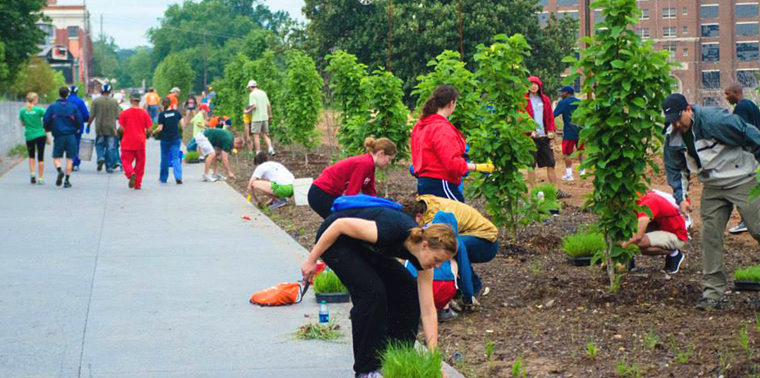
 Photo courtesy of Trees Atlanta
Photo courtesy of Trees AtlantaJuly 14, 2017 — Brilliant shades of purple, yellow and orange beckon hikers and bikers to maturing meadows in the urban center. Parents stroll children along trails cooled by the fragrant breezes of native magnolia, dogwood, oak and long leaf pine trees. Families picnic near a 40-foot cascading waterfall.
This scene in the heart of Atlanta, Georgia, is a far cry from what it was nine years ago. Back then, trucks illegally dumped toxic chemicals, trash and tires here. Kudzu and other weeds flourished, forming ad hoc habitat for rats and copperhead snakes.
Now, the Atlanta BeltLine is wiping out blight with 33 miles of multi-use trails along a historic rail line that encircles the city’s core. The ring of infrastructure is boosting environmental awareness in a metropolis that has been better known for suburban sprawl than parklands. Although other cities are turning abandoned tracks into greenways, the US$4.8 billion project connecting 45 neighborhoods offers unique lessons on urban renewal.
Master Vision
It was a master’s degree thesis that sparked the movement to build the BeltLine. In 1999, Ryan Gravel, then an architecture student at Georgia Tech, envisioned and fleshed out a plan to build a modern transit system to replace a ring of decaying rail tracks that encircled the capital city.
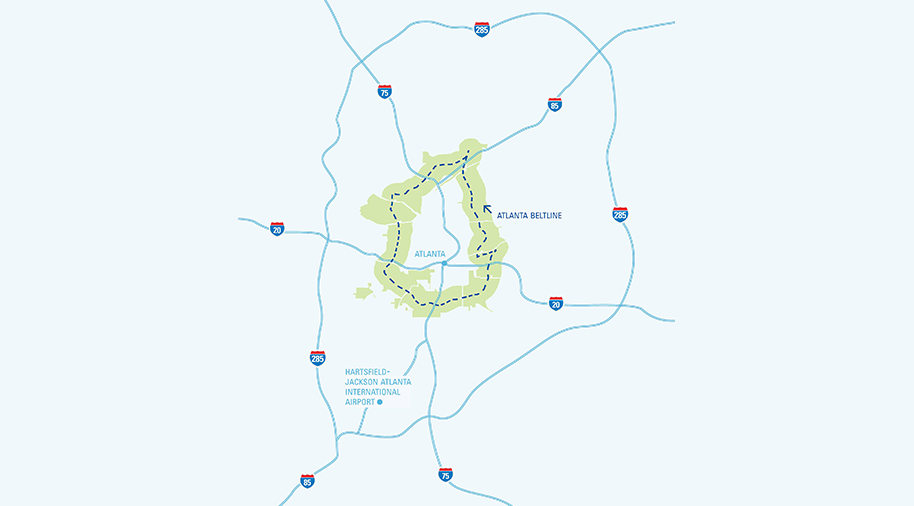
Atlanta’s BeltLine is replacing urban blight with multi-use trails and greenery along 33 miles of former rail line. Map courtesy of Atlanta BeltLine, Inc.
It took several years of negotiating among politicians, city officials, community advocates, real estate developers, landscape architects and environmentalists to solidify a proposal. Then, in 2006, Atlanta established the Atlanta BeltLine, Inc., known as ABI, to lead a renovation funded by private donors and the city that includes bike trails, parks, water management systems, housing, electric transit, art sculptures and more. According to Gravel, the project is the most extensive of its kind in the United States.
“I wanted to make Atlanta a place I wanted to live in,” he says. “Who would have thought that this idea would take off? It has been fun, excruciating and rewarding.”
Bringing Back Biodiversity
This network-in-the-making is boosting environmental awareness in a city that used to be better known for its traffic jams and sewage-polluted streams. Efforts to clean up 1,100 acres (450 hectares) of contaminated brownfields and plant more than 3,000 indigenous trees and grasses are bringing back biodiversity not seen in decades.
“The native plantings they have done had a tremendous positive impact,” says Berry Brosi, associate professor of environmental science at Emory University. “We found enormous areas in terms of pollinator abundance.”

Pollinator-friendly vegetation is helping boost biodiversity and rebuild healthy ecosystems along the trail. Photo courtesy of Trees Atlanta
In fact, an unpublished study Brosi conducted found on average three times as many bee species and five times as many bees in pollinator planting sites along the BeltLine than in mowed grass.
“I noticed for the first time in my backyard, we are seeing bees, butterflies, even fireflies, which is different than four years ago,” says Chad Ralston, who lives nearby and bikes almost daily.
One major reason for the increase in biodiversity has been the native forest created under the supervision of Trees Atlanta, a non-profit organization dedicated to protecting Atlanta’s urban canopy. Trees Atlanta has planted 19 acres (8 hectares) of indigenous trees and grasses around the abandoned tracks. Ten more acres of reforestation are planned for next year.
“It has been a challenge in what different parts of the community want and what we want,” says Greg Levine, the organization’s co-executive director and chief program officer. Local residents like the green space, Levine says, but often prefer it manicured.
“They want more mowing, and then you don’t have the pollinator habitat,” Levine says. “They like the look of a meadow, but it takes three years.” Levine says Trees Atlanta and the city have reached an agreement to just mow along the edges of the path once a year, keeping the trails clear. Goats are also used to munch on the nonnative kudzu for environmental and economic benefits.
Economic Boon
As Head of Growth and Grassroots for ASW Distillery, Ralston helped convince his company to open a new location on a part of the BeltLine known as the Westside Trail. The real estate in the vicinity is booming and is the biggest economic driving force in the city, says Atlanta mayor Kasim Reed.
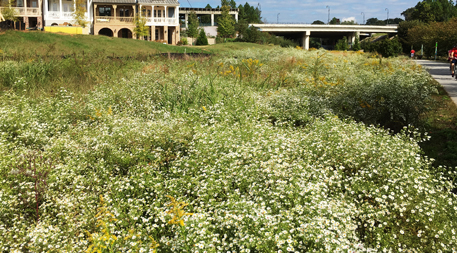
Real estate is booming along the BeltLine. Photo courtesy of Trees Atlanta
Meanwhile, Atlanta is discovering that going green can save money. The city was planning to build a US$40 million concrete vault and tunnel system to store stormwater in the Fourth Ward. Every time it rained flooded sewers sent pollution into local streams, and the city had already paid the federal government more than US$19 million in fines for its cracked and broken sewer system.
ABI stepped in to work with city officials to develop a better way to deal with storm water and sewage. The plan was to build a park bordering the Eastside Trail that recycles stormwater for a lake, fountain and waterfall. The ABI team saved the city at least US$15 million in stormwater infrastructure costs with its innovative design for the Historic Fourth Ward Park.
Cost savings “are where we hook people in,” says Heather Hussey-Coker of ABI. “But we solved one of the issues in a green way, a beautiful way.”
“The park has won awards for its plantings [and] wetlands, now home to Canada geese, ducks and turtles,” says Kit Sutherland, a community advocate who helped build the 17-acre (7-hectare) park. It also set the standard for how the BeltLine and Atlanta work together to transform former industrial areas whose belching chimneys earned them the title of “sewers of smoke.”
The Atlanta BeltLine is trying to create more energy than it uses, too. An architectural solar canopy provides shade and sells electricity back to Georgia Power. Solar-powered trash compacter bins help save the city time, energy and money by wirelessly transmitting signals to garbage collectors when it’s time to empty the cans, instead of having trash picked up on a schedule even if the cans are not full. LED lampposts line pathways, saving electricity and minimizing light pollution.
The city’s West Side is about to get a big boost because of the BeltLine. An abandoned quarry will soon add 300 acres (121 hectares) of green space adjacent to the Westside Trail. The new Westside Reservoir Park will be a source for 30 days of water, instead of Atlanta’s current three-day supply. Even though last year’s drought has ended, Atlantans still face watering restrictions because the city’s major reservoir is below full pool. Lawns can only be watered two days a week, and home car washes are forbidden.
Changing Lifestyles
Reed says the corridor is altering the way people get around. “It’s a healthy form of mobility. The bike paths and trails are changing the way in Atlanta we live,” he says. “The greater the density, the less pollution.”
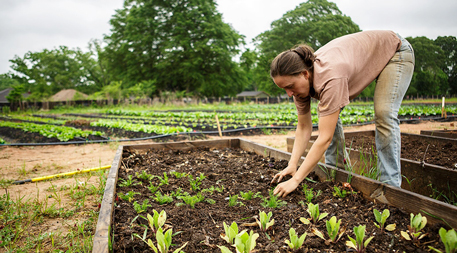
BeltLine designers turned a former bus repair facility along the route into a 6-acre urban farm. Photo courtesy of Atlanta BeltLine, Inc.
It’s changing diets, too. BeltLine designers transformed an old bus repair facility with underground fuel tanks into a 6-acre (2.4-hectare) urban farm. They cleaned up arsenic-stained soil and excavated buried garbage to revitalize the ground. Now urban farmers produce an abundance of cucumbers, tomatoes, carrots and other vegetables that feed a neighborhood unaccustomed to fresh produce. The rest is sold at the nearby Ponce City Market, once an abandoned department store that has been revitalized into a thriving shopping and food court that serves as the commercial anchor of the BeltLine.
But success is triggering new problems. With the real estate boom catalyzed by the BeltLine’s infrastructure, affordable housing is scarce, and the trail is crowded. There is little research on the environmental impacts the increased density and expanded use have spawned. Construction of 22 miles of light rail transit next to the paths is expected to alleviate some of these concerns.
“The light rail will help with changing lifestyles,” says Ralston. “I’m one of those millennials. I don’t care to drive. I don’t like sitting in traffic.”
“I get it,” Gravel says. “There is anger about the BeltLine being overcrowded. I bike. But that just means we need more bike lanes.”
Mildred Spalding, a biker who has lived in Atlanta for 43 years, was one of the 1.7 million Eastside trail users last year.
“It’s the best thing ever to happen to Atlanta,” she says. “It’s changing how I think of Atlanta.”
For Gravel, the BeltLine’s visionary, it’s a dream come true, not only professionally but personally as well.
“Not long ago, I had to take my kids with me to the grocery store,” he says. “My kids didn’t want to ride in the car. ‘Can’t we ride our bikes instead?’ Of course we can, that’s what people in Atlanta do. We ride bikes to the grocery store.” ![]()
Editor’s note: Judith Moen produced this feature as a participant in the Ensia Mentor Program. Her mentor for the project was Nate Berg.